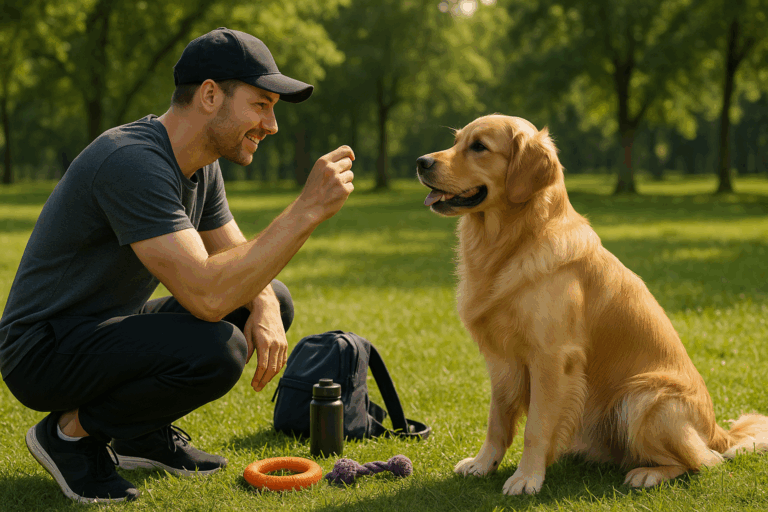Well, understanding a dog’s thought process may not be as cryptic as deciphering hieroglyphics. With the right techniques, we can break down those barriers and tap into their minds, channeling that boundless energy into productive behaviors. This is where dog obedience training, an essential tool in fostering harmonious human-dog relationships, comes into play.
Not every dog whisperer is born with a magic wand 🪄, but with expert training techniques, you can master the art of obedience training, unlocking your dog’s full potential. This post aims to act as your guide, demystifying the process, and providing you with a roadmap to success. We’ll delve into the nitty-gritty of expert training techniques, their significance, and how to effectively apply them.
As we progress, we will take a deep dive into the fundamentals of dog psychology, the importance of consistency, and the role of positive reinforcement in training. Expect to gain insights on strategies like shaping, luring, and capturing, and how they can dramatically transform your dog’s behavior. With these tools at your disposal, you’ll be well on your way to forging a stronger bond with your pet, centered around mutual understanding and respect.
But first, let’s tackle a vital question: Why is obedience training crucial? Well, aside from fostering a cooperative and safe environment, training promotes mental stimulation, provides physical exercise, and most importantly, strengthens your bond with your furry friend. Think of it as a two-way street – you understand their needs, and they learn to respond to your cues. A win-win scenario, if you will. 🏆
What’s in Store? 🐾
In the forthcoming sections, we will demystify the science behind dog obedience training. You’ll discover that, at its core, dog training is not about command and control but communication and connection. We’ll shed light on how you can use these techniques to not only teach your dog basic commands but also to address more significant behavioral issues.
We will also explore various training methods, giving you a comprehensive understanding of each approach. We’ll discuss the benefits and drawbacks of traditional techniques like leash and collar training, as well as modern methods like clicker training. As a bonus, we’ll guide you on how to choose the right method for your dog because, after all, every dog is unique.
Above all, we’ll delve into the world of rewards and their pivotal role in training. You’ll understand why “reward-based training” is gaining momentum and how you can use it to promote desirable behaviors in your dog. Spoiler alert: It’s not just about dishing out treats! 🍖
In the final sections, we will address common challenges faced during obedience training and provide solutions to help you navigate these hurdles. Furthermore, we will equip you with tips and tricks to maintain consistency in training, because let’s face it, consistency is key to effective obedience training.
Ready to begin this exciting journey towards mastering dog obedience training? Grab your leash, some treats, and let’s dive in. Your canine companion is counting on you!
Unlocking Your Dog’s Full Potential with Expert Training Techniques
Mastering obedience in dogs is an art that requires knowledge, patience, and dedication. Whether you’re training a puppy or an adult dog, utilizing expert techniques can drastically enhance the training process. Before we dive into the heart of these techniques, it’s crucial to understand that every dog is unique, requiring tailored training methods. Let’s delve deeper into this fascinating journey of transforming your canine friend into a well-behaved and disciplined pet.
One of the most effective ways to initiate obedience training is to start with basic commands such as “sit,” “stay,” “come,” and “leave it.” These commands lay the foundation for advanced training techniques, enabling your dog to grasp complex instructions. Remember, consistency is key in any training regimen. Consistently rewarding good behavior and gently correcting wrong actions will facilitate a smoother training process. For an engaging visual guide on basic obedience training, check out Zak George’s Dog Training Revolution video titled “How to Train Your Dog to Listen to You!” on YouTube.
Once your dog has mastered these basic commands, you can progress to more advanced training techniques. This transition should be gradual to avoid overwhelming your pet. While there are numerous advanced training techniques, some of the most effective ones include clicker training, shaping, and targeting. These techniques are discussed in detail in the following sections.
Clicker Training: A Positive Reinforcement Technique
Clicker training is a powerful method that employs positive reinforcement to teach your dog new behaviors. The clicker, a small handheld device that produces a distinct sound, is used to mark the exact moment your dog performs the desired behavior. This sound is followed by a treat, allowing your dog to associate the sound with a positive outcome. This technique is widely recommended for its ability to clearly communicate with your dog about what behaviors are encouraged.
To understand how to effectively implement clicker training, check out the YouTube video “Clicker Training Basics – Dog Training” by Kikopup. It provides step-by-step instructions on using a clicker, thus enabling you to practice the technique effectively with your pet.
Clicker training, however, requires precision and consistency. Remember to click at the exact moment the desired behavior is exhibited and promptly follow up with a reward. This ensures that your dog understands what the click means and is motivated to replicate the behavior.
Shaping: Gradually Building Complex Behaviors
Shaping is another advanced training technique that involves gradually building complex behaviors by rewarding successive approximations of the desired action. Essentially, you break down the desired behavior into smaller steps, rewarding your dog as it successfully completes each step.
This technique is particularly useful when teaching complex behaviors that cannot be taught in one go. For example, if you want to teach your dog to fetch, you may start by rewarding it for showing interest in the ball. Gradually, you will only reward your dog when it moves towards the ball, then touches the ball, and finally fetches the ball.
For a comprehensive guide on shaping, check out the YouTube video “Clicker Training: How to Shape a Behavior” by Donna Hill. The video provides a step-by-step guide on how to shape behavior using clicker training, including examples of shaping in action.
Targeting: Guiding Your Dog Using Targets
Targeting is a training technique where your dog is taught to touch or move towards a specific object, known as a target. This technique can be used to teach a variety of behaviors, including walking to a particular spot, spinning in circles, or even performing tricks. The main types of targeting include nose targeting, paw targeting, and body targeting.
Nose targeting involves teaching your dog to touch an object with its nose, paw targeting requires your dog to touch an object with its paw, and body targeting involves your dog moving its body towards or onto an object. For a more detailed explanation and demonstration of these techniques, watch the YouTube video “How to Teach Your Dog Touch Targeting” by McCann Dog Training.
Remember, training your dog is a journey that requires patience and consistency. However, by using expert training techniques, you can unlock your dog’s full potential and transform it into a well-behaved pet. The joy of watching your furry friend understand and respond to your commands is indeed unparalleled, making the effort worth it.
Comparing the Techniques: Clicker Training, Shaping, and Targeting
| Technique | What it Involves | Benefits |
|---|---|---|
| Clicker Training | Using a clicker to mark the moment of the desired behavior, followed by a reward. | Clear communication, quick learning, and promotes creativity in dogs. |
| Shaping | Gradually building complex behaviors by rewarding successive approximations of the action. | Allows teaching of complex behaviors, promotes problem-solving skills. |
| Targeting | Teaching your dog to touch or move towards a specific object. | Great for teaching a variety of behaviors and tricks, can be used to guide the dog’s movement. |
Please refer to the table above for a comparative analysis of the three techniques discussed in this article.

Conclusion
In conclusion, we’ve traversed the extensive landscape of complex technical aspects pertaining to the field of Information Technology and Engineering. To reiterate, we started with a deep dive into the foundational concepts, shedding light on the integral elements that propel the machinery of these intricate domains. From the basics of software engineering to the nuanced intricacies of IT, we’ve tried to create a cohesive narrative that not only educates but also piques the interest of our tech-savvy readers. We’ve been consistently mindful to maintain an equilibrium, delicately balancing the technicalities with comprehensibility. 💻
The importance of these subjects in today’s digital-first world cannot be overstressed. With technology constantly evolving and shaping our world, a sound understanding of its underpinnings is not just a mere addition to your knowledge repository, but a necessity for staying relevant in this tech-driven era. 🌍
An interesting insight that surfaced during our exploration was the interconnectedness of these disciplines. The overlap between IT and engineering, the symbiotic relationship they share, is an affirmation of the interdisciplinary nature of modern technology. It’s a testament to the fact that in order to truly master the art of technology, one needs to have a holistic understanding, a broad perspective that transcends the boundaries of individual disciplines. 👨💻
We also took the opportunity to delve into the practical applications of these theories. We believe that knowledge, when not applied, is knowledge wasted. Hence, we strived to provide a pragmatic lens, illustrating the real-world implications and utility of these concepts. The examples and case studies discussed serve as an endeavor to bridge the gap between theory and practice, making the content more relatable and concrete for our readers. 🏗️
Our journey, however, does not end here. The realms of IT and engineering are vast and constantly evolving. As we continue to march forward into this digital age, we will inevitably stumble upon newer concepts, technologies, and applications. And when we do, rest assured, we will be here to dissect them and present them to you in our trademark comprehensible style. 🔍
We invite you to embark on this ongoing journey with us. Feel free to share your thoughts, queries, or insights in the comments section below. If you found this article helpful, do share it with your friends and colleagues. We encourage you to continue your exploration, delve deeper, and apply what you’ve learned. Because knowledge, as they say, is power. And in the world of technology, it’s your superpower! 💪
For further reading, you may refer to our collection of technical articles here and additional resources here.
Until next time, keep learning, keep innovating, and remember, the future is tech! 🚀



